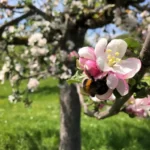Coral bells, scientifically known as Heuchera, are a captivating group of perennial plants that have earned their place as cherished additions to gardens around the world. These plants are celebrated not only for their charming, bell-shaped flowers but also for their striking foliage that comes in a spectrum of colors, from vibrant greens to deep purples and rich oranges. However, amidst their ornamental beauty lies a question that often lingers in the minds of gardeners: Are coral bells deer-resistant? In this article, we embark on a journey to understand the allure of coral bells and explore whether their appeal extends to being spared from the browsing appetites of deer.
- Beautiful Fall colors can give your landscaping a beautiful addition any time of the year!
- Please note: Our shipping occurs only one time for up to 5 items, so please check out all our plants and bulbs to make the most of your shipping dollar
- Zone 4-8, full sun to partial shade
- Height 1-3 ft, spread 1-3 ft
- Very showy foliage, a favorite at the nursery!
Coral Bells
Coral bells, belonging to the Heuchera genus, are native to North America and are commonly found in various regions, from woodlands to rocky slopes. These hardy perennial plants have gained popularity in gardens for several reasons:
- Foliage Variety: One of the hallmark features of coral bells is their diverse foliage. The leaves can be round or heart-shaped and come in an array of colors, including shades of green, silver, purple, and bronze. The foliage often boasts intricate veining and marbling, adding to their visual appeal.
- Bell-Shaped Flowers: Coral bells produce delicate, bell-shaped flowers that rise on slender stems above the foliage. These flowers, which can be white, pink, coral, or red, attract pollinators such as hummingbirds and butterflies.
- Versatile Growth: These perennials thrive in various conditions, from full sun to partial shade, making them adaptable to a range of garden settings. They are often used in borders, containers, and as ground cover.
- Low Maintenance: Coral bells are generally low-maintenance plants. They are drought-tolerant once established and require minimal pruning.
- Year-Round Interest: While their flowers typically bloom in late spring to early summer, the foliage of coral bells provides year-round interest, making them a valuable addition to the garden even when not in bloom.
Coral bells have a lot to offer in terms of aesthetics and versatility, which makes them a sought-after choice for gardeners looking to enhance their landscapes. However, their potential vulnerability to deer browsing raises questions about how they fare when these graceful creatures roam the garden. To unravel the mystery of whether coral bells are deer-resistant or not, we delve further into the behavior of deer and the factors that influence their plant preferences.
Deer Behavior and Plant Preferences
Understanding deer behavior is crucial when assessing the deer resistance of plants like coral bells. Deer are known to be selective browsers, and their preferences can vary depending on several factors:
- Browsing Habits: Deer are herbivores and will graze on a variety of plants. However, they tend to favor plants that are tender, succulent, and easily accessible. They are more likely to target new growth, buds, and foliage.
- Seasonal Variation: Deer preferences can change with the seasons. In spring and summer, when other food sources are abundant, they may be less inclined to browse on certain plants. However, in winter when food is scarce, they may resort to nibbling on less favorable options.
- Local Deer Populations: The level of deer pressure in a particular area can influence their behavior. In regions with high deer populations, they may be more daring in their plant choices due to competition for food.
Are Coral Bells Deer Resistant?
Determining whether coral bells are deer-resistant can be a complex task. While coral bells are not typically considered deer magnets, the extent of their deer resistance can vary. Some gardeners report that deer do not show strong interest in coral bells, while others have observed occasional browsing.
Factors Influencing Deer Resistance
Several factors can influence whether coral bells are spared from deer damage:
- Variety: The specific variety of coral bells may affect their deer resistance. Some varieties may possess natural characteristics that make them less appealing to deer, such as tougher foliage or bitter-tasting leaves.
- Local Deer Population: The density of deer in a given area can impact their behavior. In regions with abundant deer, they may become more adventurous in their plant choices, potentially including coral bells in their diet.
- Alternative Food Sources: The availability of alternative food sources can influence deer behavior. If other preferred plants are plentiful, deer may be less likely to target coral bells.
- Repellents and Barriers: Gardeners can employ various strategies to deter deer, such as using deer-resistant plants as companions, applying deer repellents, or using physical barriers like fencing.
Ultimately, whether coral bells are considered deer-resistant can depend on the specific circumstances of your garden. Some gardeners may find their coral bells remain largely untouched by deer, while others may need to employ protective measures to preserve these elegant perennials.
- Tough durable deer netting; Protects landscape and crops from deer and other animals
- Economical, lightweight deer protection; Black UV-resistant deer netting
- Reusable mesh deer fence; Stops deer and other animals from eating shrubs, berries, and vegetables
- Easy to use roll of deer fence netting; Attaches easily to posts and trees
- Do it yourself deer netting for protecting trees, shrubs, orchards and crops
Strategies for Protecting Coral Bells
Gardeners who wish to safeguard their coral bells from potential deer browsing can employ various protective strategies:
- Deer Repellents: Deer repellent sprays and granules are available in garden stores. These products emit odors or tastes that deter deer from approaching your plants. Reapply as directed on the product label, especially after rain.
- Fencing: Installing physical barriers like deer fencing can be an effective way to keep deer away from your coral bells. Ensure the fence is at least 7-8 feet tall to deter deer from jumping over.
- Companion Planting: Surrounding your coral bells with plants known to be deer-resistant can create a protective barrier. Deer are less likely to venture into areas with less appealing food options.
- Motion-Activated Devices: Motion-activated sprinklers or lights can startle deer and discourage them from entering your garden.
- Garden Monitoring: Regularly inspect your garden for signs of deer browsing. Early detection allows for prompt action, such as the application of repellents or adjustment of protective measures.
Alternative Landscaping Choices
In areas with persistent deer pressure, gardeners may consider alternative plants that are less attractive to deer. Some deer-resistant options include:
- Lavender (Lavandula): Known for its fragrant blooms and silvery foliage, lavender is often avoided by deer due to its strong scent.
- Russian Sage (Perovskia atriplicifolia): This perennial features delicate, aromatic foliage and tall spires of blue-purple flowers, which deer tend to avoid.
- Salvia (Salvia spp.): Many varieties of salvia are known for their deer resistance. They produce spikes of colorful flowers and aromatic foliage.
- Lambs Ear (Stachys byzantina): With its soft, fuzzy leaves, lambs ear is not a favored food for deer.
- LIGHT & SOIL: Thrives in full sun or light shade, in average, dry to medium, well-drained soils. Can tolerate poor soil conditions.
- TALL: Extremely easy to grow, Lamb’s Ears features a low, spreading habit and forms a compact mound up to 6-8 in. tall or 12-18 in. in flower with a spread of 12-36 in.
- BLOOM PERIOD: Pink-purple flower spikes appear in late spring or early summer.
- USES: Wonderful for edging beds, softening hard corners and walks, massed as a ground cover, as an accent in the border, underplanting roses or shrubs or in rock gardens.
- USDA ZONE: Lamb’s Ear does best in USDA zones 4 to 10.
Conclusion
Coral bells, with their captivating foliage and delicate blossoms, bring a touch of elegance to gardens. While they are not typically at the top of the deer menu, their deer resistance can vary depending on various factors. Gardeners who cherish these plants may need to employ protective measures such as deer repellents, fencing, or companion planting to ensure their coral bells remain unscathed by browsing deer.
Ultimately, the deer resistance of coral bells should be viewed in the context of your specific garden and local deer population. Understanding deer behavior, local conditions, and alternative landscaping choices can help you strike a balance between preserving the beauty of your garden and coexisting with these graceful creatures. Whether you decide to protect your coral bells or explore alternative plantings, the world of gardening offers a multitude of options to create a landscape that thrives in harmony with nature.






